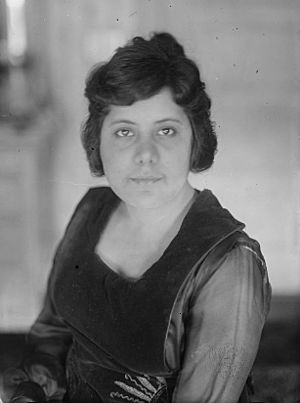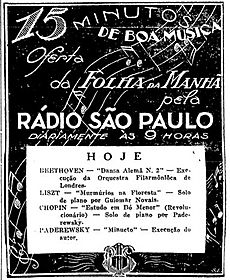Guiomar Novaes facts for kids
Quick facts for kids
Guiomar Novaes
|
|
|---|---|

Novaes in 1919
|
|
| Born | February 28, 1895 São João da Boa Vista
|
| Died | March 7, 1979 (aged 84) |
Guiomar Novaes (born February 28, 1895 – died March 7, 1979) was a famous Brazilian pianist. She was known for her unique sound and how she played music. People loved her beautiful, flowing melodies and her thoughtful, detailed way of interpreting songs.
About Guiomar Novaes
Guiomar Novaes was born in São João da Boa Vista, a town in the São Paulo state of Brazil. She was one of the youngest in a very large family. She started learning piano with teachers like Antonietta Rudge Miller and Luigi Chiafarelli.
In 1909, when she was just 14, she was accepted to study at the Conservatoire de Paris in France. This was a big deal because only two spots were open for foreign students, and 387 people applied!
Guiomar played for a special group of judges, including famous composers like Debussy and Fauré. She played difficult pieces by Paganini-Liszt, Chopin, and Schumann. She won first place! Debussy was amazed by her playing. He wrote that she played with "tremendous beauty and complete absorption," forgetting about everyone else around her.
Even at a young age, Guiomar had her own ideas about music. Her teacher, Isidor Philipp, once told her to play a part of a Beethoven song slower. Guiomar thought about it, then played it again at the same speed, but with small changes. She did this several times! Philipp eventually gave up, saying she "had a mind of her own." He later said she was one of his best students ever.
By the end of 1910, Guiomar was already an experienced concert performer. She made her official debut with the Chatelet Orchestra. She also played in England, Italy, Switzerland, and Germany.
When World War I started, she returned to Brazil. In 1915, at just 19 years old, she made her first performance in the United States at Aeolian Hall in New York City. Critics loved her. One called her "a musician by the grace of God," and another called her "the young genius of the piano." She was even nicknamed "the Paderewska of the Pampas," comparing her to a famous male pianist.
Guiomar continued to play often in the United States, especially in New York. In 1922, she married Octavio Pinto, who was a civil engineer, a pianist, and a composer. She kept performing throughout her life, even into the 1970s. For many years, she would come to New York every December for a single concert at Carnegie Hall. Her loyal fans would wait in long lines, even in the snow, to get tickets.
Her last concert in New York was in 1972. Guiomar Novaes passed away in São Paulo on March 7, 1979, after having a stroke.
Her Unique Style
When Guiomar Novaes was younger, she played many different pieces of music. Later in her life, she focused on a smaller number of pieces. No matter what she played, she always performed with a very elegant style. Her music always had a beautiful, flowing melody, and she played with complete freedom and freshness.
She looked very relaxed and natural at the piano. It seemed as if the piano was a part of her arms and fingers. The sound she made and the delicate way she played reminded people of the great Romantic pianists from earlier times. Her technique was smooth and flexible, never trying too hard for a special effect.
Her playing was always deeply poetic. Music critic Harold C. Schonberg wrote that her performance of the Schumann piano concerto was "strikingly reminiscent" of another great pianist, Josef Hofmann. He said it had the same smoothness, delicate sound, and steady rhythm. Like Hofmann, Guiomar never played a piece exactly the same way twice. Each time, she brought a slightly different idea to the music, and it always felt right and natural.
Schonberg also wrote that "The sheer beauty of her playing managed to go beyond any other thoughts; it was its own reward." He added that while there might have been more powerful or intellectual pianists, it was hard to think of anyone whose playing brought as much pure joy as Guiomar Novaes.
David Dubal, another writer about piano music, said that her playing was "first and always personalized." He noted that she loved small details in the music that others might miss. Even when she played in a playful way, she had the amazing ability to convince listeners that her way was the right way. Everything she played felt very personal and close, especially the music of Chopin.
Her Musical Legacy
Guiomar Novaes was especially famous for how she played the music of Chopin and Schumann. Her performances were full of small details and deep understanding.
She made many recordings throughout her career. Some of her earliest recordings from the 1920s and 1940s have been put together on CDs. Later, especially in the 1950s, she recorded for Vox Records. One of her most famous recordings is Beethoven's Piano Concerto No. 4 with the Vienna Symphony Orchestra. Musicians and critics highly praise this recording.
She also recorded concertos by Mozart, Schumann, Grieg, and Falla. The famous Brazilian Chopin expert Nelson Freire said that Guiomar's recording of Chopin's Second Piano Concerto deeply influenced him. He heard it when he was 14 and saw it as an ideal to work towards.
Many of her recordings of concertos, short encore pieces, and Chopin solo works have been re-released on CD. A special 3-CD set includes Chopin's etudes, 20 nocturnes, and his famous Piano Sonata No. 2 (also known as the "Funeral March" sonata). Most of her highly praised Schumann recordings were released on CD in 2009. Her teacher, Isidor Philipp, encouraged her to record Mendelssohn's Songs Without Words, saying they were "unduly neglected." These, along with her Debussy recordings, have not yet been officially released on CD.
See also
 In Spanish: Guiomar Novaes para niños
In Spanish: Guiomar Novaes para niños



